

Music SoftwareTraining and Ableton Blog. Attack Of The 8 Bar Loop So there you are, staring at your computer screen. 12 tracks of brilliance, or at least 15 seconds of it.
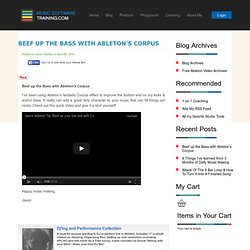
You sit there listening to the loop on repeat over and over again, trying to convince yourself that you are being creative, instead of just stuck. Audio, Distortion and Feedback. Lyric Writing Exercises: a 5-Day Workshop. Guest post by Maria Rainier If you’re anything like most songwriters, you’re all too familiar with that frustrating sensation of being stuck in a rut.
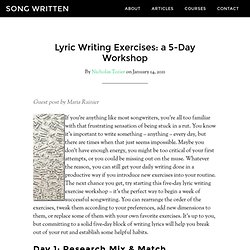
You know it’s important to write something – anything – every day, but there are times when that just seems impossible. Maybe you don’t have enough energy, you might be too critical of your first attempts, or you could be missing out on the muse. Whatever the reason, you can still get your daily writing done in a productive way if you introduce new exercises into your routine.
The next chance you get, try starting this five-day lyric writing exercise workshop – it’s the perfect way to begin a week of successful songwriting. (free trance-house-techno-dance-hardstyle-midi, patches, remix, music, community) Compressor control principles. A short compendium on digital audio compression techniques.
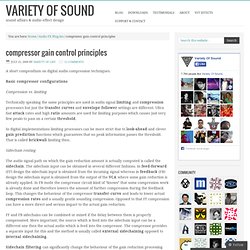
Basic compressor configurations. Pensado's Place - Learn how to produce, record, mix, and master music and audio. Metering. Audio metering is one of the most confusing and complex aspects of sound recording.
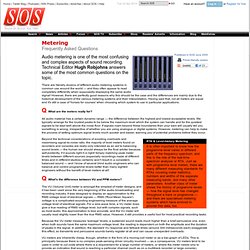
Technical Editor Hugh Robjohns answers some of the most common questions on the topic. There are literally dozens of different audio metering systems in common use around the world — and they often appear to read completely differently when supposedly displaying the same audio signal! However, there are perfectly good reasons why this should be the case and the differences are mainly due to the historical development of the various metering systems and their interpretation. Dither vs Distortion. The video above demonstrates what quantisation distortion sounds like, and how dither solves the problem.
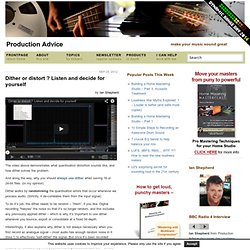
And along the way, why you should always use dither when saving 16 or 24-bit files. Harnessing The Power Of DSP. In the previous segment, we looked at the basic process of using a high-resolution FFT (Fast Fourier Transform) analyzer to view the frequency and phase response of a 12-inch cone driver in a typical 12-inch/2-way loudspeaker.

In that segment, we established that the 30-degree off-axis response of the cone driver is substantially lower in level (12 to 18 dB), as well as highly irregular in phase and frequency above approximately 2 kHz, when compared to the driver’s on-axis response (Figure 1). This information allows us make an educated guess at the range where the cone driver should be crossed over. In this particular case, the 30-degree off-axis response is linear up until about 1.28 kHz, after which the output until about 2 kHz. Audio 101. Digital. Big Bad Bass - A Tutorial on Low Frequencies.
Sub-bass occupies the frequency range from 20 - 100 Hz.

It is not so much heard, but felt. Sub-bass is responsible for creating a low-end presence that gives a bassline its power. Special attention should be paid to this layer as low frequencies take up a lot of headroom in a song. Getting the sub-bass just right is an art. The Basics of Musical Pitch. Music Production Tips from Tenth Egg. Assigning Samples To Keyboard For Recording [Archive] - AudioForums.com. The SOS Guide To Mix Compression. Technique : Effects / Processing.
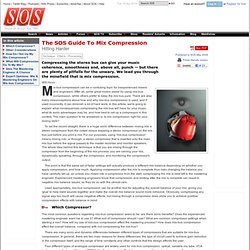
Audio and production tutorials, from beginner to advanced. Tonespace 2.0. What is tonespace?

It's a different, more intuitive music keyboard, combined with a chorder It supports over 50 different grids, 14 scales, 18 keys, 30+ chord types and 25 chord voicings it can function as a VST or Audio Unit plugin, processing incoming MIDI events and/or generating outgoing MIDI you don't need to use MIDI though: there is also a standalone executable which contains its own little synth for a fast start what can you do with it? Audition and play chords while you move the mouse around in a grid-like space, or while using a traditional keyboard learn how musical scales and keys work, and how chords relate to these, using the simple octave-based spaces discover how chords map onto surprisingly simple geometric shapes in the more advanced spaces use chord-generation algorithms to fit chords to scales and keys automatically trigger chords from monophonic midi input and record the played chords using midi output.
Audio. Make music together. Let's get started making music...

How To Create Electro... Lead? Bass? To be honest, I’m not sure what this sound is specifically… Some may call it bass, some may say it’s more like a lead, but it’s definitely something you can hear in many Electro House tracks. I got the inspiration for this while listening some sample cd’s and after experimenting with FL Studio this is what I came up with: Is this something in a style of Mode Selektor, Daft Punk, etc?
- Tracking : Resources and Information. Look here for articles on applied recording techniques and mic placement. It all starts here! Acoustic Guitar Tracking the acoustic guitar is a huge subject, because so much contributes to the final sound—player, instrument, room acoustics, mic choice and placement, effects, and more. Here are some timeless articles with solid advice to get you started on developing your own acoustic recording toolbox. Electric Guitar The electric guitar is the central sound of rock music, and has influenced everything from blues and country to electronica.
Bass Recording the bass can be as straightforward as a simple DI to the console or as complex as multiple mics on an acoustic bass fiddle or giant amp stack. Other Guitars. Studio beta. Soundtracker. Voice123 - The Voice Over Marketplace - Voice Overs, Voice Actors, and Talents. How to Calculate Delay Time to Tempo Beat « ConradAskland.com. Here’s how to calculate millisecond delay time to your tempo so you can make adjustments on the fly (or just set it correctly for a hardline beat delineation.)
Needless to say, if you’re not going for strict tempo beat pulses then you can skip equations and do this “by feel”.It’s very simple if you remember this equation: * Delay time in ms (Milli-seconds) = 60000/BPM (Beat Per Minute) How to setup your device to control your DAW (Enigma SETUP FILES & More) Effects: All You Need To Know... And A Little Bit More. Technique : Effects / Processing Whether you're a beginner or a seasoned pro, there's always something to learn about adding colour to your mix. Paul White. Mysteries Of Metering. Technique : Theory + Technical All mechanical meters are VU meters, all bargraph meters read peak levels -- and both types will give the same reading if you feed in a test tone. Reasonable enough assumptions, but wrong on all counts, as PAUL WHITE explains. The really wonderful thing about standards is that there are so many of them, and nowhere is this more evident than when you look at metering. This article examines the complicated issue of metering standards, but those unfamiliar with the general terminology of metering (eg. dBu, dbv, and the conventions of 'plus 4' and 'minus 10' operation) are advised to check out my article from SOS February 1994, 'dBs Explained', which should clarify many of the terms used here.
Ableton. Electronic Music Tutorial (How to write beats) 47 Sites Every Recording Musician Should Visit. In a recent “Open Mic” we asked you, “Which music-related sites do you visit regularly?” This article is a summary of the great suggestions given in the comments to that article. You can make the list even longer by commenting on this article. As you’re reading this article, Audiotuts+ needs no introduction. Several commenters mentioned Audiotuts+ - thanks for the support!
For fun.